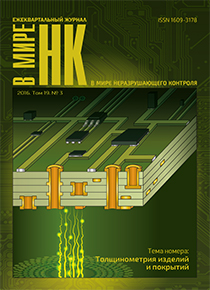Introduction. The approach and practical implementation for the sensitivity calibration and its equalizing within entire insonified cross-section of the material have been presented in the article for 3 most common reference artificial reflectors, namely the flat bottom hole (FBH) situated at parallel to the weld bevel plane, the EDM notch (N), and the side drilled hole (SDH). The method. The issue of inhomogeneous sensitivity over cross-section covered through phased array (PA) sectorial scan plan is due to several factors, which are highlighted and explained. 5 of them are independent on the reference reflector’s shape. In addition the FBH and N reference reflectors are characterized by the strong dependency of the echo amplitude on the angle, under which the ultrasonic wave hits their surface (factor 6, which differs the FBH and N from the omnidirectional SDH). The approach for equalizing the sensitivity over sectorial-scan-insonified cross-section of the material for all types of reference reflectors has been proposed and explained. It is based on the ability of ultrasonic PA flaw detector to implement each pulsing-receiving cycle among the plurality of the scan-plan-forming set of focal laws with individually and independently settled gain and other key settings including Distance Amplitude Correction / Time Corrected Gain (DAC / TCG). The Sonotron NDT’s ISONIC Series PA instruments (ISONIC 3510, ISONIC 2010, and ISONIC 2009 UPA Scope) are featured with the said ability uniquely: in the said units the DAC / TCG mechanism is used purely for compensating the dependency of echo amplitude on the material travel distance while the feature of varying Gain per Focal Law is utilized just for the forming of easy-reproducible Angle Gain Compensation (AGC) plan. Both the DAC / TCG and AGC plans are created independently on each other with use of the same reference reflectors. The results. Combining of the independent DAC / TCG and AGC mechanisms for the first time ever provides the equalizing of the sensitivity for all types of reference reflectors independently on their X, Y position over the entire cross-section of the material — this is confirmed by a number of experimental results presented. Conclusion. At last the single group sectorial scan only becomes sufficient for the complete coverage of the whole cross-section of the weld. This allows reducing the dimensions of required PA probes and wedges in use and the width of the area for the scanning along the fusion line. And finally this increases the maximal possible speed of scanning along with reducing of the inspection cost.
ultrasonic testing, PA flaw detector, ультразвуковой контроль, sensitivity equalizing, DAC, TCG, welded joint





